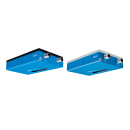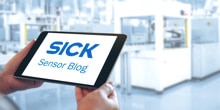With ultra-high precision and without damaging the high-quality four color printed images, the non-contact SPEETEC movement sensor detects the exact positioning of color separations on the print heads in the CorruJET 170 digital printing press from Koenig & Bauer Durst. Another impressive aspect of the measurement system at the Würzburg printing press manufacturer was the flat design of the SPEETEC for space-saving and mounting-friendly integration.
Ecobox instead of plastic bag: non-contact movement and position measurement in a digital printing press
Different corrugated board substrates and blank formats, a large variety of carton types and printed designs, as well as the needs-based and at the same time economical production of small to medium size batches – the CorruJET 170 printing press from Koenig & Bauer Durst. “Developed specifically for the corrugated industry, the CorruJET 170 is engineered for the highly efficient production of corrugated sheets with top-quality digital printing,” explains Oliver Baar, Senior Product Manager at Koenig & Bauer Durst at the time. “Operating with a maximum production speed of 5,500 sheets/hour, the CorruJET 170 is able to process corrugated boards up to a maximum thickness of 8 mm.”

The end product includes, among other things, so-called ecoboxes – corrugated boxes with digital direct printing for use, for example, in retail. There they are offered to consumers in place of plastic bags to carry their purchases home. “The ecoboxes are more than simply a reusable means of carrying items,” says Oliver Baar, “they are a high-value promotional item that is intended to convey the image and value of the retailer through the visual quality of the printed designs and logos.” His colleague Thomas Schneider, responsible for drive technology and signal processing at Koenig & Bauer Digital & Webfed, adds: “Process technology-wise, this means that no color shifts, blurriness or shadow patterns are allowed to occur in the four color printing that would negatively impact on the visual impression of quality of the ecoboxes.”
Position measurement on corrugated board: SPEETEC's threefold advantages

Precise positioning of the color separations at the two printing heads of the CorruJET 170 is achieved thanks to the SPEETEC measurement system: It ensures, with high measurement accuracy, that the printed colors in the sequential print passes are printed on top of each other without displacement. The sensor does this by measuring the speed of the plastic suction belt on which the sheet is transported through the machine. “Two SPEETECs have been installed in the press – one in front of each of the 2 two-color print heads which together produce the four color print”, explains Thomas Schneider. “With the measurement sensor from SICK, the digital printing units can be controlled with great precision and positioned in the correct place.”
Application technology-wise, SPEETEC prevailed over three possible alternatives. One was measurement via encoder systems in the head rollers that drive the conveyor system. This option was discarded because the encoder values alone did not provide sufficiently accurate position information due to the stretching of the plastic belt used to transport the corrugated board blanks. The second possibility – movement and position measurement by means of tactile measuring wheels – was ruled out because they come into contact with the prepared and, at the second print unit, already partially printed surface and also drop down to the conveyor belt in the gaps between the blanks and then rise up again at the next corrugated sheet. “This falsifies the measurement result to such an extent that precise positioning of the individual color layers on top of each cannot be reproducibly ensured,” Thomas Schneider explains. The SPEETEC with its precise position measurement, on the other hand, ensures no color shifts occur during four color printing and, as a result, the individual colors of the multi-color print are precisely registered on top of each other."
Non-contact and yet cost-effective
SPEETEC was also found to be superior to a third alternative: laser velocimeters. While these also perform non-contact measurement, they generally turn out to be a significantly poorer choice in terms of total cost of ownership due to their comparatively high price and the safety-related high integration and operating expenses. The latter is due to the fact that common velocimeters use class 3 laser light. This necessitates a range of technical and organizational protective measures, and the effort and additional costs that go with these. Not so with the SPEETEC: the speed sensor uses a class 1 laser. In this lowest hazard class, the output of the transmitter is so low that it poses no risk to the eyes. No additional safety-related expenses are incurred, so the SPEETEC is also easy to integrate.
Automation solution and development tool in one
Thomas Schneider confirms that the SPEETEC in the CorruJET 170 has proven to be a highly available and maintenance-free automation solution. It is therefore envisaged to also use the sensor for other machine families for large-format, analog printing on corrugated board. The SPEETEC is also a popular choice at Koenig & Bauer Durst when developing solutions to particular measurement-related technical challenges.








